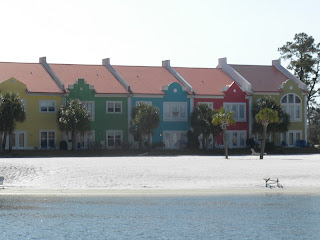November 21: A good weather prediction allowed us to leave Fairhope, Alabama and head down Mobile Bay to the Gulf Intercoastal Waterway (GIWW). The GIWW stretches from Brownsville, Texas in the West to Fort Myers, Florida (FL). Most of the route is in protected waters with barrier islands forming a barrier between the coast and the open waters of the Gulf of Mexico. The one exception is an open water stretch between Carabelle, FL and Tarpon Springs, FL. More on that later.
Sections of the GIWW are connected by man made canals or "ditches "as the locals call them.
The GIWW passes through some very shallow areas. Fortunately, the channel is well marked and at least 9 feet deep. This is one of the markers on the channel. Guarded by a pelican.
Our first stop was in Homeport, AL as we had made arrangements to have our autopilot checked there. Unfortunately, swinging the compass and replacing certain parts did not solve our problem. So we will have to live with the autopilot the way it is for the time being. Homeport is the home to Lulu's restaurant which is owned by Jim Buffet's sister Lulu. It has a "Caribbean" atmosphere, lots of Jim Buffet music playing and decent burgers but nothing to rave about.
November 22-23: Pensacola, Florida: Today, we entered into Floridian section of the Intercoastal Waterway en route to Pensacola.
Beautiful white sand and clear water.
Sections of the GIWW are part of the Gulf Island National Seashore Park which prohibits any construction.
While other sections allow residential construction.
Colorful townhouses.
Pensacola was originally founded by the Spanish in 1559 who established a colony with 1,500 settlers but it failed after 2 years. This statue in the harbor is dedicated to those early Spanish pioneers.
No one was too interested in giving the Admiral a ride though...maybe showing a leg would have worked. Then again, maybe not!
We spent several hours at the Museum but could have spent several days. Well worth a visit.
Retired Blue Angel Planes suspended in their standard formation.
Many early, one of a kind planes on exhibit. Our guide was a retired naval aviator with a rich knowledge of Naval Aviation. All the guides are volunteers.
World War 2 German jet that was developed right at the end of the war. Fortunately, not too many were built.
Japanese Zero Plane. Only a handful still exist. Our guide explained to us that these planes were superior in performance to the ours. US planes were designed and built to save the pilot. They had armor plating and fuel bladders in the wings were designed to reseal if punctured by gunfire. These features made the US planes heavier and less nimble. The Japanese planes were built for speed and maneuverability. If their fuel tanks were ruptured, the planes exploded. They were also lighter because they did not have armor plating. The pilots were thus less protected and more exposed. The result was that they lost more pilots. This strategy of faster and more nimble planes paid off in the beginning of the War in the Pacific but not later as they lost too many experienced pilots.
WW1 plane
Downtown Pensacola honors the US Armed Services with Pelican Statues.
US Coast Guard
Building Mural
City Hall.
More white sandy beaches. We have also seen dozens of dolphins. They surface and swim next to the boat but are too fast for us to photograph.

The Martians have landed. Actually, an Air Force Radar tower. Large US Military presence in this neck of the woods.
We were amazed at the number of large high rise condominiums that are located on the barrier islands. Not our first choice in a hurricane.
US Coast Guard
Pensacola has a picturesque downtown with interesting architecture and some great restaurants.
Building Mural
City Hall.
November 24: Thanksgiving Day: We thoroughly enjoyed Pensacola but have to press on down the Intercoastal Waterway. Today our stop is the free dock at Fort Walton.

The Martians have landed. Actually, an Air Force Radar tower. Large US Military presence in this neck of the woods.
We were amazed at the number of large high rise condominiums that are located on the barrier islands. Not our first choice in a hurricane.

























































